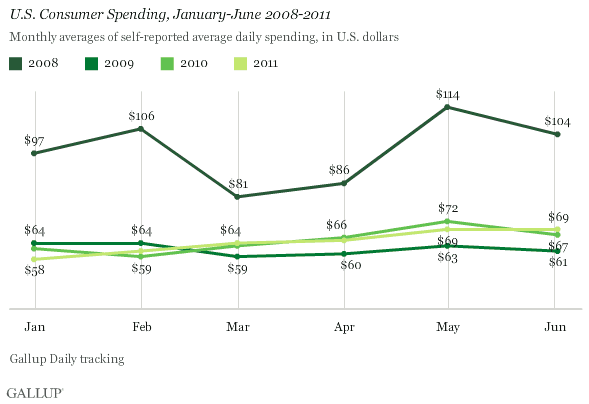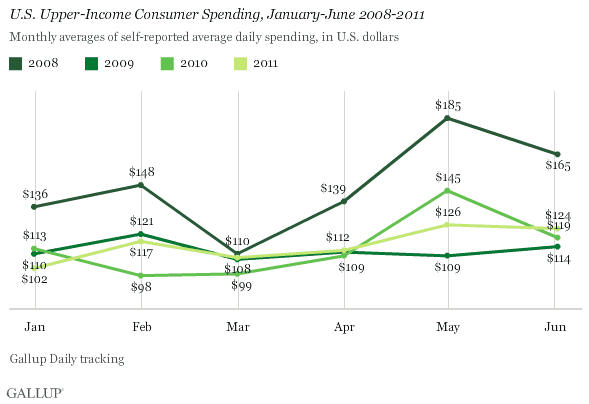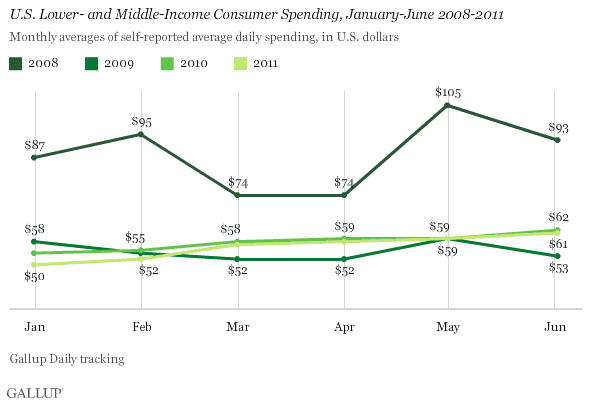PRINCETON, NJ -- Overall self-reported daily consumer spending in stores, restaurants, gas stations, and online averaged $69 per day during June -- unchanged from May, and essentially the same as the $67 average of June 2010.

Consumer spending has shown no improvement over the first half of 2011 compared with 2010, but remains slightly higher than in 2009. Still, spending in all three years has been in the "new normal" range -- at levels far below those of 2008.
Upper-Income Spending Also Reflects the "New Normal"
Upper-income spending (among Americans making $90,000 or more annually) averaged $124 per day in June -- essentially the same as the $126 of May and not much better than the $119 average of June 2010. Although these Americans are likely to have more disposable income to spend freely when they choose, they continue to hold back and to spend within the "new normal" range -- which is far below what they were spending three years ago.

Lower- and Middle-Income Spending Also in the "New Normal" Range
Americans who make less than $90,000 per year reported spending an average of $61 per day during June -- up slightly from the previous three months. However, these Americans' spending habits during the first half of 2011 have remained in the 2009-2010 "new normal" range.

Implications
Flat consumer spending is consistent with today's low level of economic confidence. It also squares with the idea that the U.S. economy remained in a so-called "soft patch" during the second quarter. Further, even though gas prices have declined -- which would theoretically help increase consumer spending -- pump prices remain far above year-ago levels, and continue to reduce other spending.
Decreasing unemployment and underemployment is likely the key to increasing lower- and middle-income consumer spending. Gallup's Job Creation Index for June, which is at its highest level since September 2008, may provide some hope things are getting better in this regard, at least on the margin.
On the other hand, upper-income Americans show little sign that they feel confident enough to spend more. The weak housing market and talk of a soft patch most likely don't help these Americans feel better about spending. Nor do the increasingly intense partisan battles over raising the debt ceiling.
The U.S. economy could regain momentum as Japanese auto plants in the U.S. return to building cars in the months ahead. Some economists feel the overall impact of the crisis in Japan on the supply chain worldwide, and on U.S. jobs in particular, has been greatly underestimated. If gas prices continue to decline, they should also have a positive, tax-cut-like effect. However, to this point, consumer spending shows no signs of such a rebound.
Gallup.com reports results from these indexes in daily, weekly, and monthly averages and in Gallup.com stories. Complete trend data are always available to view and export in the following charts:
Daily: Employment, Economic Confidence and Job Creation, Consumer Spending
Weekly: Employment, Economic Confidence, Job Creation, Consumer Spending
Read more about Gallup's economic measures.
View our economic release schedule.
Survey Methods
For Gallup Daily tracking, Gallup interviews approximately 1,000 national adults, aged 18 and older, each day. The consumer spending results are based on a random sample of approximately 500 current full- and part-time employees each day.
National results for June are based on Gallup Daily tracking interviews with 14,965 employees conducted June 1-30, 2011. For this sample, one can say with 95% confidence that the maximum margin of sampling error is ±1 percentage point. Regional results for June are based on interviews totaling more than 3,000 in each region. For each total regional sample, the maximum margin of sampling error is ±3 percentage points.
For results based on the total sample of [national adults/registered voters], one can say with 95% confidence that the maximum margin of sampling error is ±4 percentage points.
Interviews are conducted with respondents on landline telephones and cellular phones, with interviews conducted in Spanish for respondents who are primarily Spanish-speaking. Each sample includes a minimum quota of 400 cell phone respondents and 600 landline respondents per 1,000 national adults, with additional minimum quotas among landline respondents for gender within region. Landline telephone numbers are chosen at random among listed telephone numbers. Cell phone numbers are selected using random-digit-dial methods. Landline respondents are chosen at random within each household on the basis of which member had the most recent birthday.
Samples are weighted by gender, age, race, Hispanic ethnicity, education, region, adults in the household, and phone status (cell phone only/landline only/both, cell phone mostly, and having an unlisted landline number). Demographic weighting targets are based on the March 2010 Current Population Survey figures for the aged 18 and older non-institutionalized population living in U.S. telephone households. All reported margins of sampling error include the computed design effects for weighting and sample design.
In addition to sampling error, question wording and practical difficulties in conducting surveys can introduce error or bias into the findings of public opinion polls.
For more details on Gallup's polling methodology, visit www.gallup.com.
